Control of Aluminum and Titanium Contents in the Electroslag Remelting of ATI 718PlusTM Alloy
Abstract
:1. Introduction
2. Experimental
2.1. The Creation of a Thermodynamic Model
2.2. The Experiment on the Balance of Slag Alloy
3. Thermodynamic Model
4. Results and Discussion
4.1. The Influence of Smelting Temperature on the Equilibrium Contents of Al and Ti
4.2. The Influence of Components in the Slag System on the Equilibrium Contents of Al and Ti
4.3. The Influence of the Initial Al and Ti Content in the Electrode on the Equilibrium Al and Ti Content of the Alloy
4.4. Validation of Thermodynamic Model
5. Conclusions
- Increases in the smelting temperature can effectively inhibit the burning loss of the Al element, while decreases in the smelting temperature can effectively inhibit the burning loss of the Ti element. In the electroslag remelting of the ATI 718PlusTM alloy, it is necessary to appropriately increase the smelting temperature. The set temperature of electroslag remelting should not be lower than 1923 K.
- Increasing the Al2O3 and CaO contents and decreasing the TiO2 and MgO contents in slag can inhibit the burning loss of Al; on the contrary, it can inhibit the burning loss of Ti. Varying CaF2 contents had little effect on the equilibrium content of Al and Ti contents; varying the MgO content could adjust the Mg content in the ATI 718PlusTM alloy.
- The initial Ti content of the electrode has a more significant influence on the equilibrium Al content of the alloy. Appropriately increasing the Ti content in the ATI 718PlusTM alloy or adding Al powder to the slag can inhibit the burning loss of Al.
Author Contributions
Funding
Institutional Review Board Statement
Informed Consent Statement
Data Availability Statement
Conflicts of Interest
References
- Du, J.H.; Lv, X.D.; Dong, J.X.; Sun, W.R.; Bi, Z.N.; Zhao, G.P.; Deng, Q.; Cui, C.Y.; Ma, H.P.; Zhang, B.J. Research Progress of Wrought Superalloys in China. Acta Metall. Sin. 2019, 55, 1115–1132. [Google Scholar] [CrossRef]
- Kracke, A. Superalloys, the Most Successful Alloy System of Modern Times-Past, Present, and Future. In Proceedings of the 7th International Symposium on Superalloy 718 and Derivatives, Pittsburgh, PA, USA, 10–13 October 2012. [Google Scholar]
- Ju, J.T.; Zhu, Z.H.; Yang, K.S.; Ji, G.H.; An, J.L.; Shi, C.B. Control of Al and Ti Contents During Electroslag Remelting of High-Temperature Ni-based Alloys. Rare Met. Mater. Eng. 2021, 50, 3550–3561. [Google Scholar]
- Chen, G.S.; Cao, M.H.; Zhou, D.H.; Jin, X. Metallurgical quality of super alloy GH4169 melted in the 5t electroslag furnace under protective Ar gas. J. Aeronaut. Mater. 2003, 23, 88–91. [Google Scholar]
- Li, S.J.; Cheng, G.G.; Yang, L.; Chen, L.; Yan, Q.Z.; Li, C.W. A Thermodynamic Model to Design the Equilibrium Slag Compositions during Electroslag Remelting Process: Description and Verification. ISIJ Int. 2017, 57, 713–722. [Google Scholar] [CrossRef]
- Li, X.; Geng, X.; Jiang, Z.H.; Li, H.B.; Xu, F.H.; Wang, L.X. Influences of slag system on metallurgical quality for high temperature alloy by electroslag remelting. Iron Steel 2015, 50, 41–46. [Google Scholar] [CrossRef]
- Bin, Y.; Wanming, L.; Shaopeng, W.; Ximin, Z.; Haocen, Y. Thermodynamic analysis of Al and Ti element loss in electroslag remelting Inconel 718 superalloy. Iron Steel 2019, 54, 86–94. [Google Scholar] [CrossRef]
- Morscheiser, J.; Thönnessen, L.; Gehrmann, B.; Friedrich, B.; Recycling, M. The Influence of the Slag Composition on the Desulfurization of Ni-Based Superalloys. In Proceedings of the 2011 International Symposium on Liquid Metal Processing and Casting, Nancy, France, 25–28 September 2011. [Google Scholar]
- Wang, X.C. Analysis on Control of Ai and Ti Content in ESR Ingot of GH3030. Spec. Steel Technol. 2006, 11, 7–9. [Google Scholar] [CrossRef]
- Melgaard, D.K.; Williamson, R.L.; Beaman, J.J. Controlling remelting processes for superalloys and aerospace Ti alloys. JOM 1998, 50, 13–17. [Google Scholar] [CrossRef]
- Pateisky, G.; Biele, H.; Fleischer, H.J. The Reactions of Titanium and Silicon with Al2O3-CaO-CaF2 Slags in the ESR Process. J. Vac. Sci. Technol. 1972, 9, 1318–1321. [Google Scholar] [CrossRef]
- Tan, J.P.; Wang, F.; Liu, Z.Q.; Baleta, J.; Li, B.K.; Zhang, B.J. A thermodynamic model for predicting Ti and Al element of SiO2-Al2O3-FeO-TiO2-CaO-MgO-CaF2 slag in electroslag remelting process. J. Mater. Res. Technol. 2023, 23, 4702–4715. [Google Scholar] [CrossRef]
- Yang, J.G.; Park, J.H. Distribution Behavior of Aluminum and Titanium Between Nickel-Based Alloys and Molten Slags in the Electro Slag Remelting (ESR) Process. Metall. Mater. Trans. B-Process Metall. Mater. Process. Sci. 2017, 48, 2147–2156. [Google Scholar] [CrossRef]
- Jiang, Z.H.; Hou, D.; Dong, Y.W.; Cao, Y.L.; Cao, H.B.; Gong, W. Effect of Slag on Titanium, Silicon, and Aluminum Contents in Superalloy During Electroslag Remelting. Metall. Mater. Trans. B-Process Metall. Mater. Process. Sci. 2016, 47, 1465–1474. [Google Scholar] [CrossRef]
- Duan, S.C.; Shi, X.; Mao, M.T.; Yang, W.S.; Han, S.W.; Guo, H.J.; Guo, J. Investigation of the Oxidation Behaviour of Ti and Al in Inconel 718 Superalloy During Electroslag Remelting. Sci. Rep. 2018, 8, 5232. [Google Scholar] [CrossRef]
- Yan, X.; Guo, Z.; Yu, X.; Wang, D. A Review on the Development of Regular Solution Model for Molten Slags and Its Application on the Metallurgical Physico-Chemistry (Part II). Shanghai Met. 1995, 17, 1–6. [Google Scholar]
- Ji, C.; Che, Y.; Xu, K. Temkin’s Model. In The ECPH Encyclopedia of Mining and Metallurgy; Xu, K., Ed.; Springer Nature: Singapore, 2022; p. 1. [Google Scholar]
- Jiang, Z. Electroslag Metallurgy; China Science Publishing & Media Ltd.: Beijing, China, 2015. [Google Scholar]
- Kennedy, R.L. Allvac® 718Plus™, superalloy for the next forty years. In Proceedings of the 6th International Symposium on Superalloys 718, 625, 706 and Derivatives, Pittsburgh, PA, USA, 2–5 October 2005; pp. 1–14. [Google Scholar]
- The Math Works, Inc. MATLAB; The Math Works, Inc.: Natick, MA, USA, 2020. [Google Scholar]
- Hou, D.; Wang, D.Y.; Zhou, X.Z.; Hu, S.Y.; Wang, H.H.; Qu, T.P. Study on Physical and Chemical Properties of Slag Used for Electroslag Remelting of Superalloy Containing Titanium and Aluminum. Metall. Mater. Trans. B-Process Metall. Mater. Process. Sci. 2022, 53, 2972–2990. [Google Scholar] [CrossRef]
- Liu, F.B.; Gao, J.Z.; Cao, H.B.; Li, H.B.; Jiang, Z.H.; Geng, X.; Kang, C.P.; Chen, K.; An, R.D. Effect of slag composition on elements oxidation behavior of GH984G superalloy for electroslag remelting withdrawal process. J. Iron Steel Res. Int. 2022, 29, 761–771. [Google Scholar] [CrossRef]
- Gong, W.; Zhou, R.A.; Wang, P.F.; Jiang, Z.H.; Geng, X. Effect of Al2O3 and TiO2 Contents in the Refining Slag on Al and Ti Contents of Incoloy825 Alloy. ISIJ Int. 2022, 62, 2255–2265. [Google Scholar] [CrossRef]
- Hou, D.; Jiang, Z.H.; Dong, Y.W.; Cao, Y.; Cao, H.; Gong, W. Thermodynamic design of electroslag remelting slag for high titanium and low aluminium stainless steel based on IMCT. Ironmak. Steelmak. 2016, 43, 517–525. [Google Scholar] [CrossRef]
- Duan, S.C.; Guo, H.J.; Shi, X.; Guo, J.; Li, B.; Han, S.W.; Yang, W.S. Thermodynamic analysis of the smelting of Inconel 718 superalloy during electroslag remelting process. Chin. J. Eng. 2018, 40, 53–64. [Google Scholar] [CrossRef]
- Yang, X.M.; Shi, C.B.; Zhang, M.; Zhang, J. A Thermodynamic Model for Prediction of Iron Oxide Activity in Some FeO-Containing Slag Systems. Steel Res. Int. 2012, 83, 244–258. [Google Scholar] [CrossRef]
- Li, Z.; Geng, X.; Jiang, Z.; Fubin, L. Deoxidation thermodynamic of electroslag remelting 304NG stainless steel. J. Cent. South Univ. (Sci. Technol.) 2023, 54, 4273–4282. [Google Scholar]
- Jian, Z. Computational Thermodynamics of Metallurgical Melts and Solutions; Metallurgical Industry Press: Beijing, China, 2007. [Google Scholar]
- Bacon, W.G.; Fraser, M.; Mitchell, A. The application of electroslag melting and welding to the manufacture of large steel components. Can. Metall. Q. 1975, 14, 161–167. [Google Scholar] [CrossRef]
- Shen, Z.; Guo, J.; Duan, S.; Guo, H.; Duan, R.; Huang, S. Thermodynamics and Optimization of a Slag System for Al and Ti Burning Loss Control of a Φ1100-mm Ni-Based Superalloy Ingot During the Electroslag Remelting Process. JOM 2023, 75, 2636–2645. [Google Scholar] [CrossRef]
- Chen, C.; Zhao, W.; Dong, D. Control of Mg Content during Electroslag Remelting of GH99 Alloy; Beijing Iron and Steel Institute: Beijing, China, 1985; p. 14. [Google Scholar]
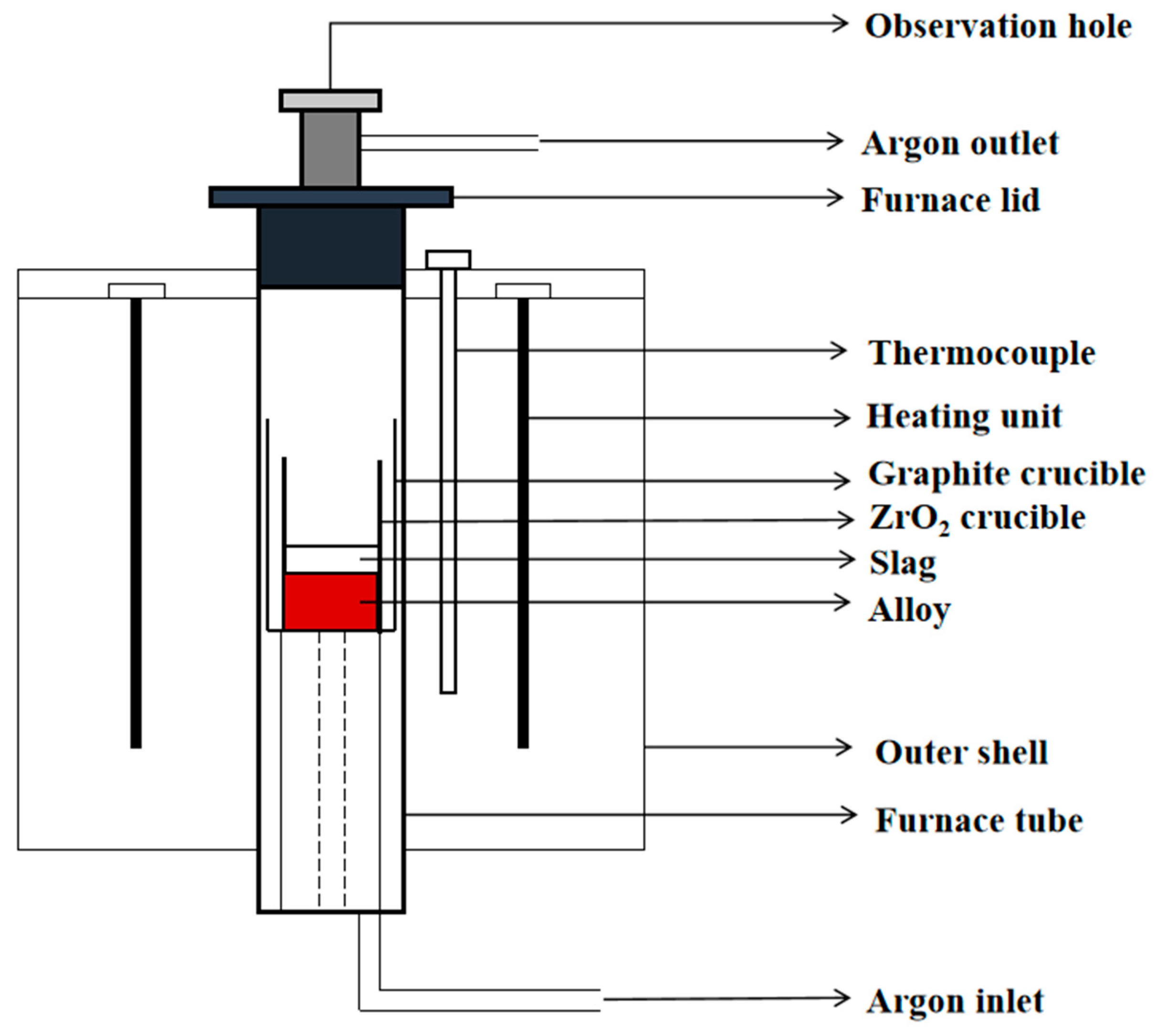
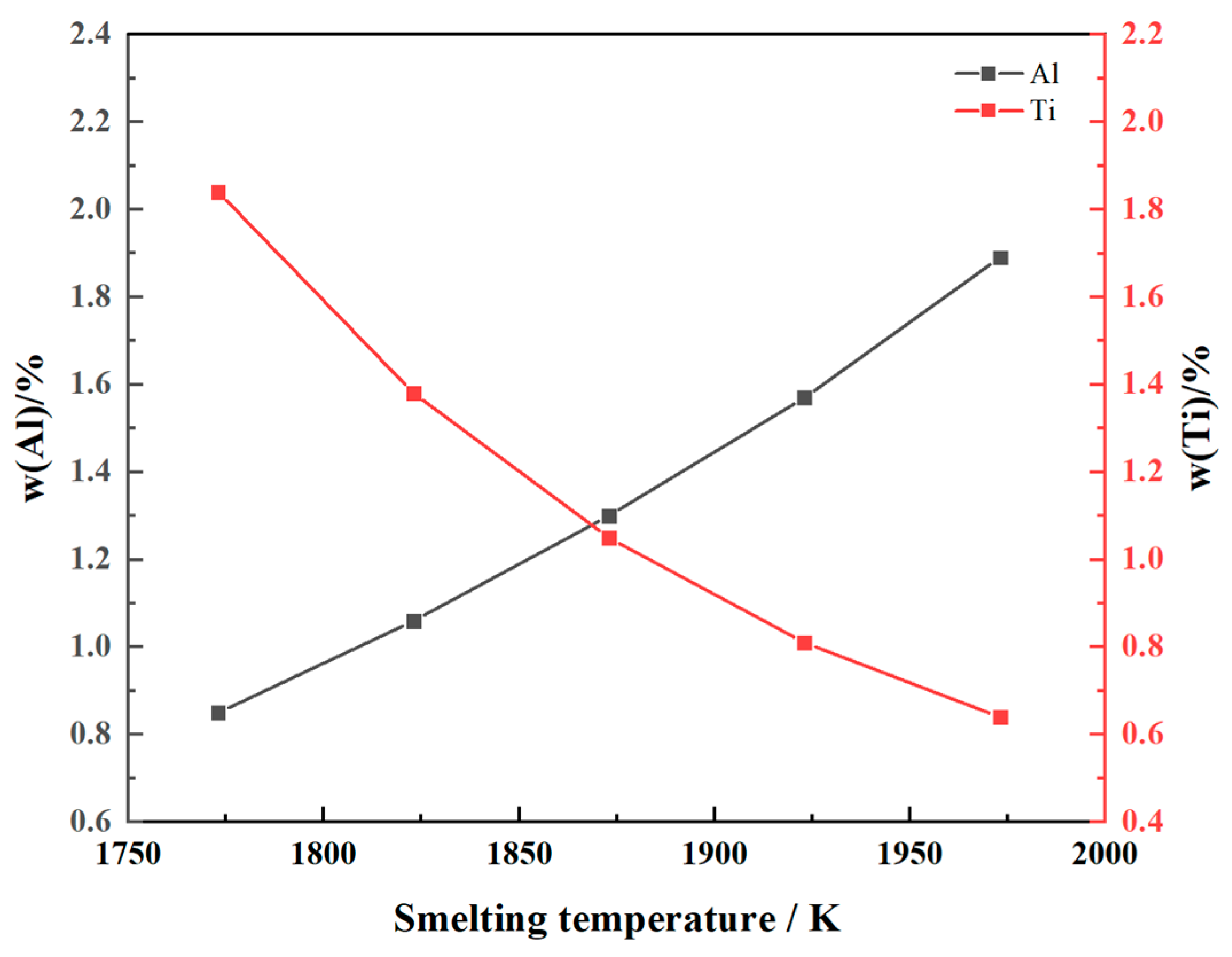
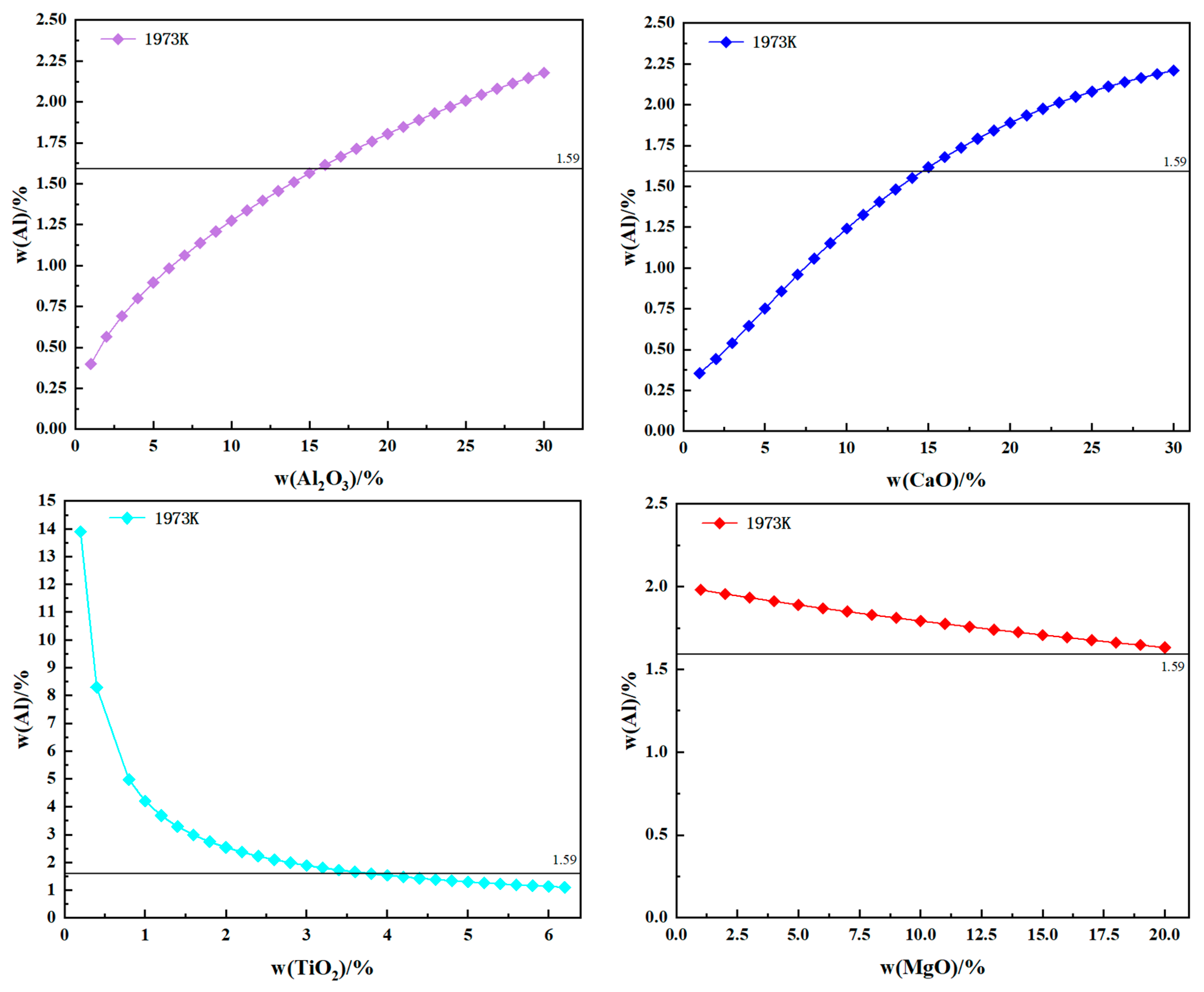

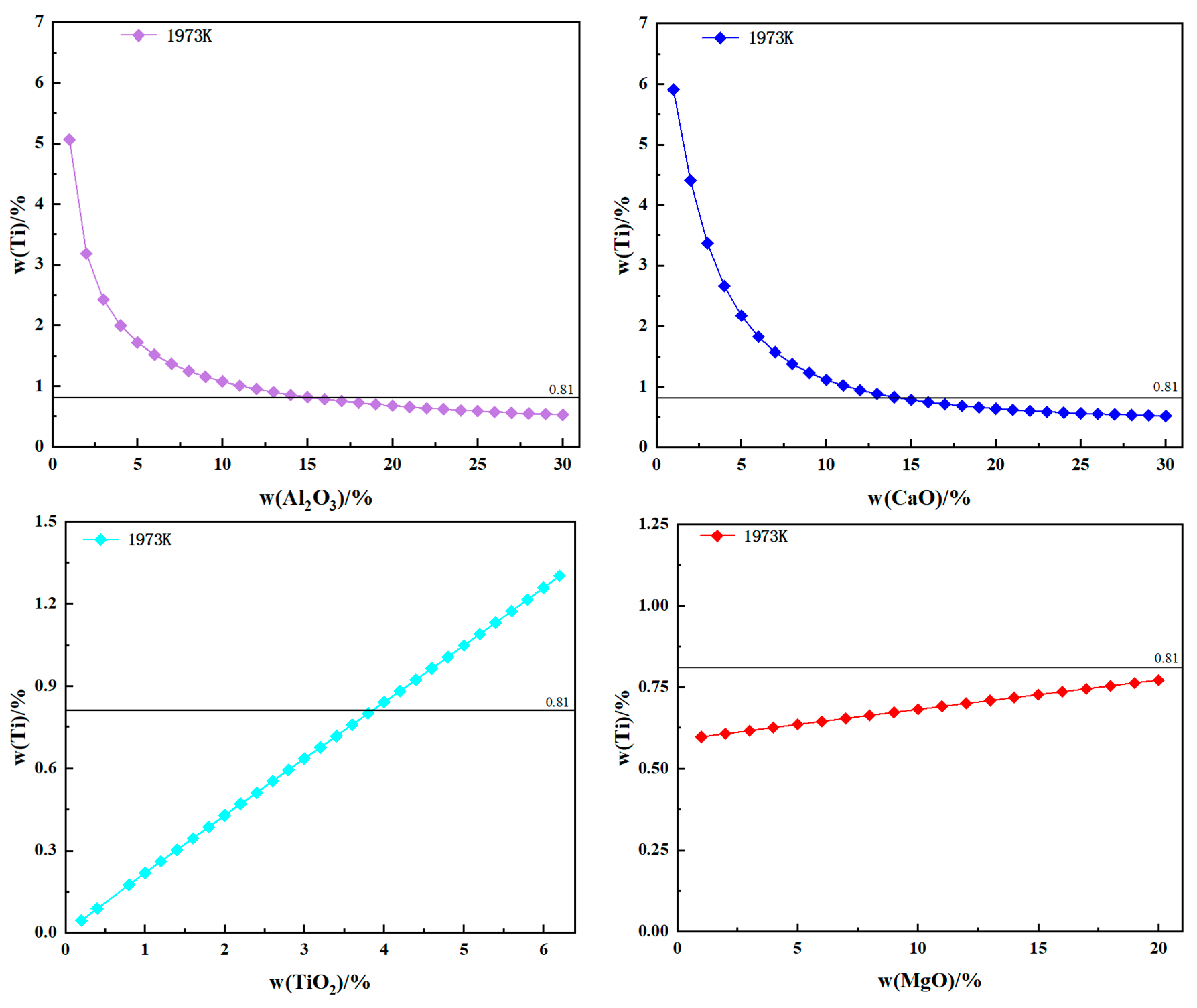
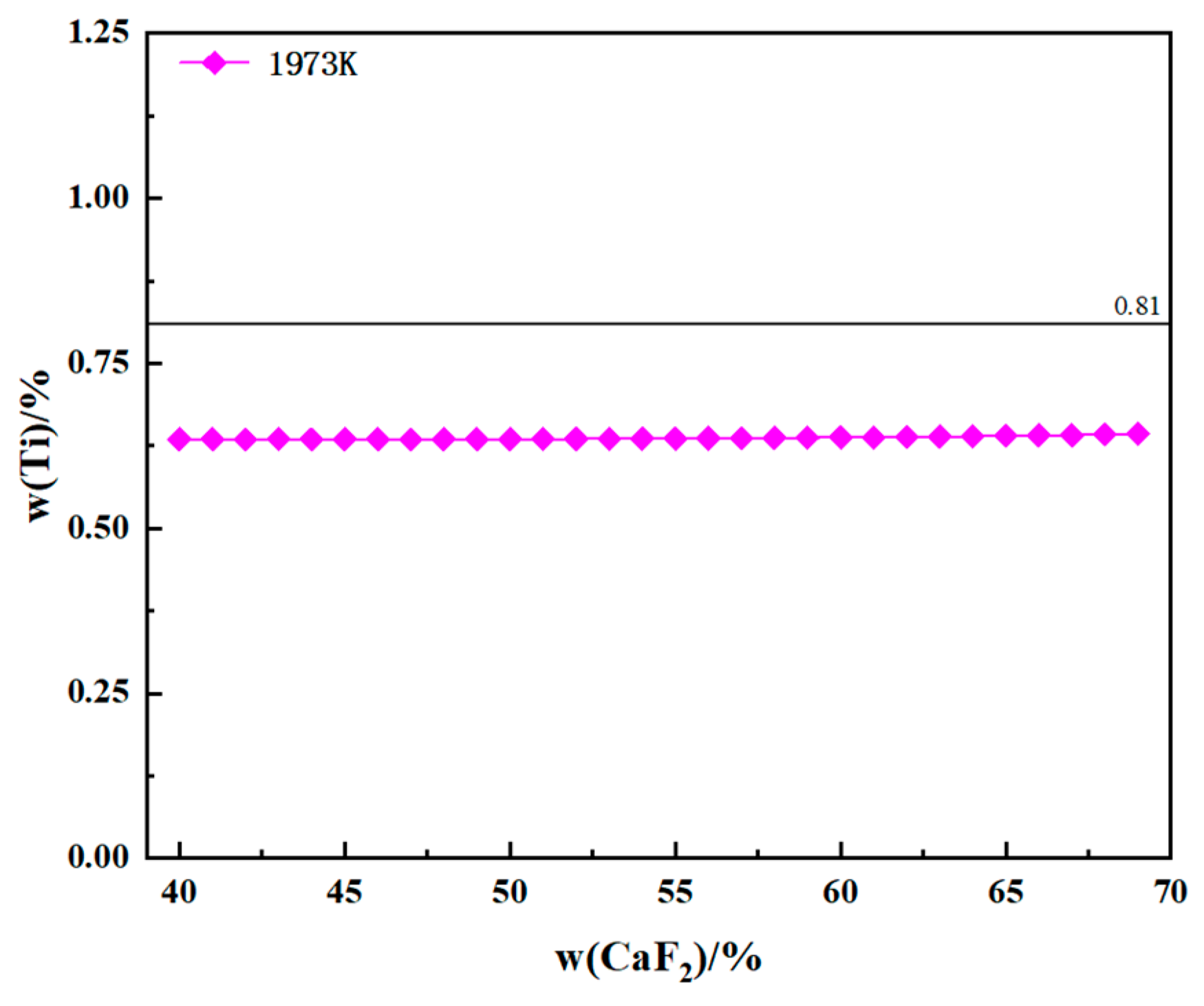

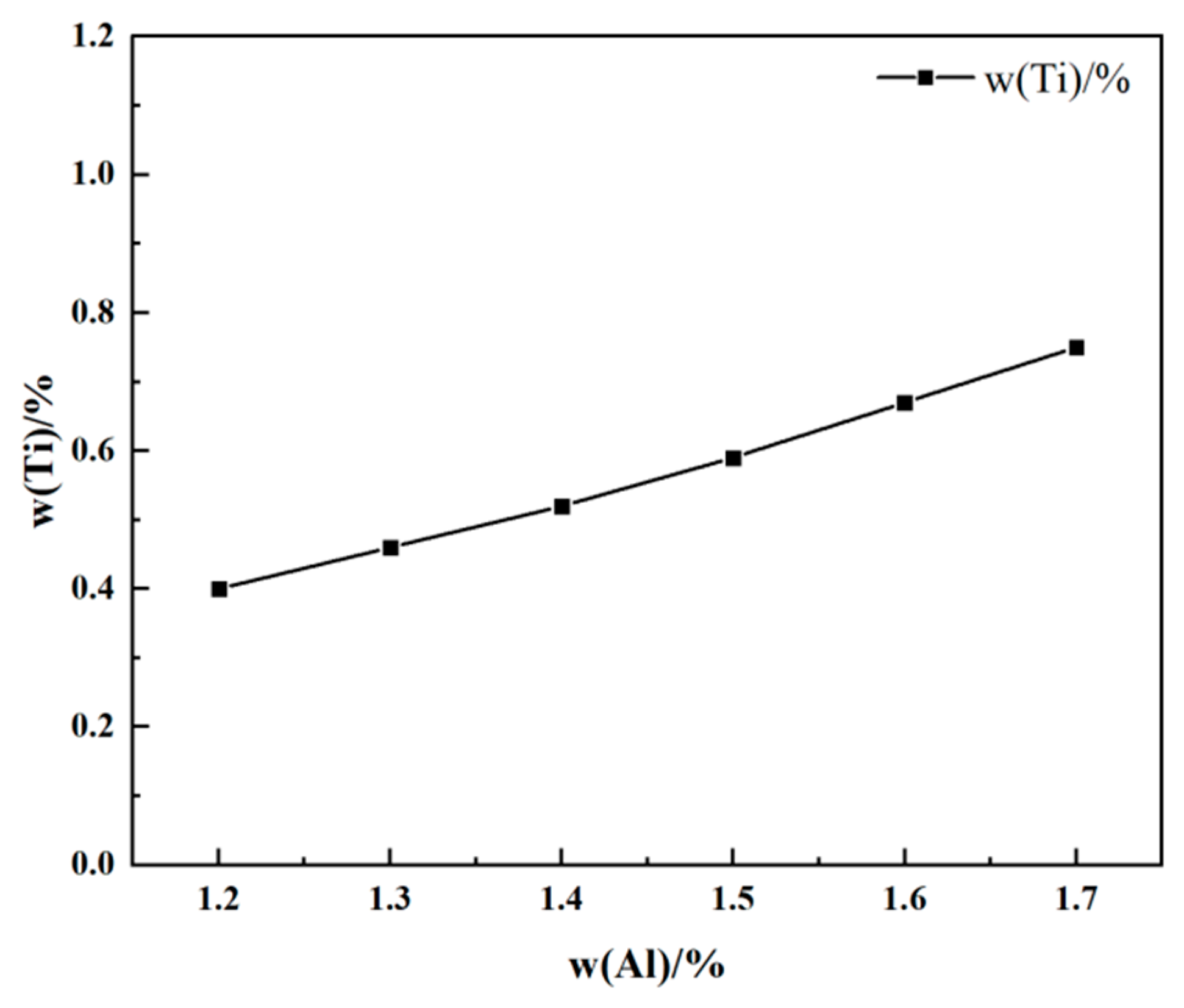
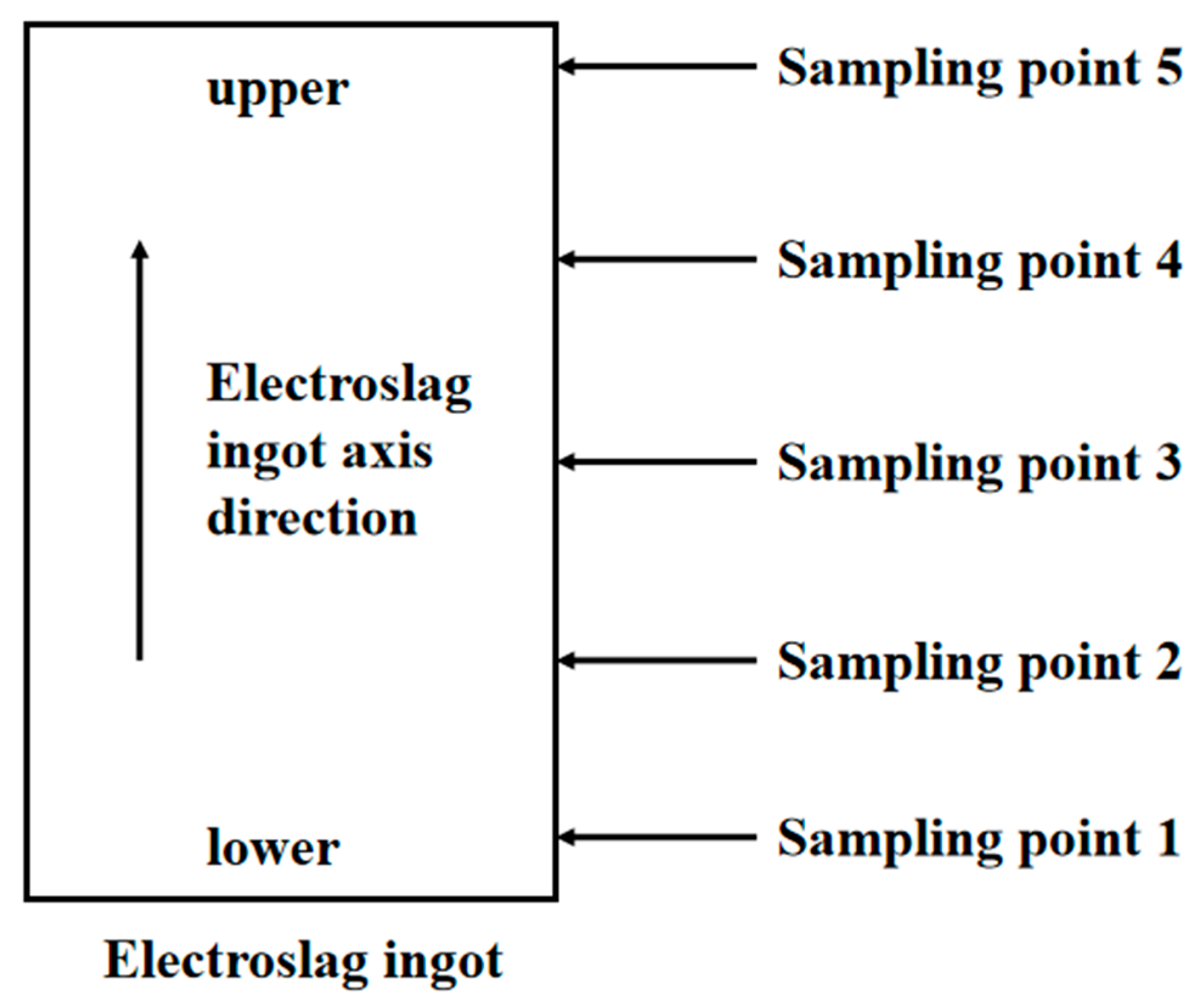
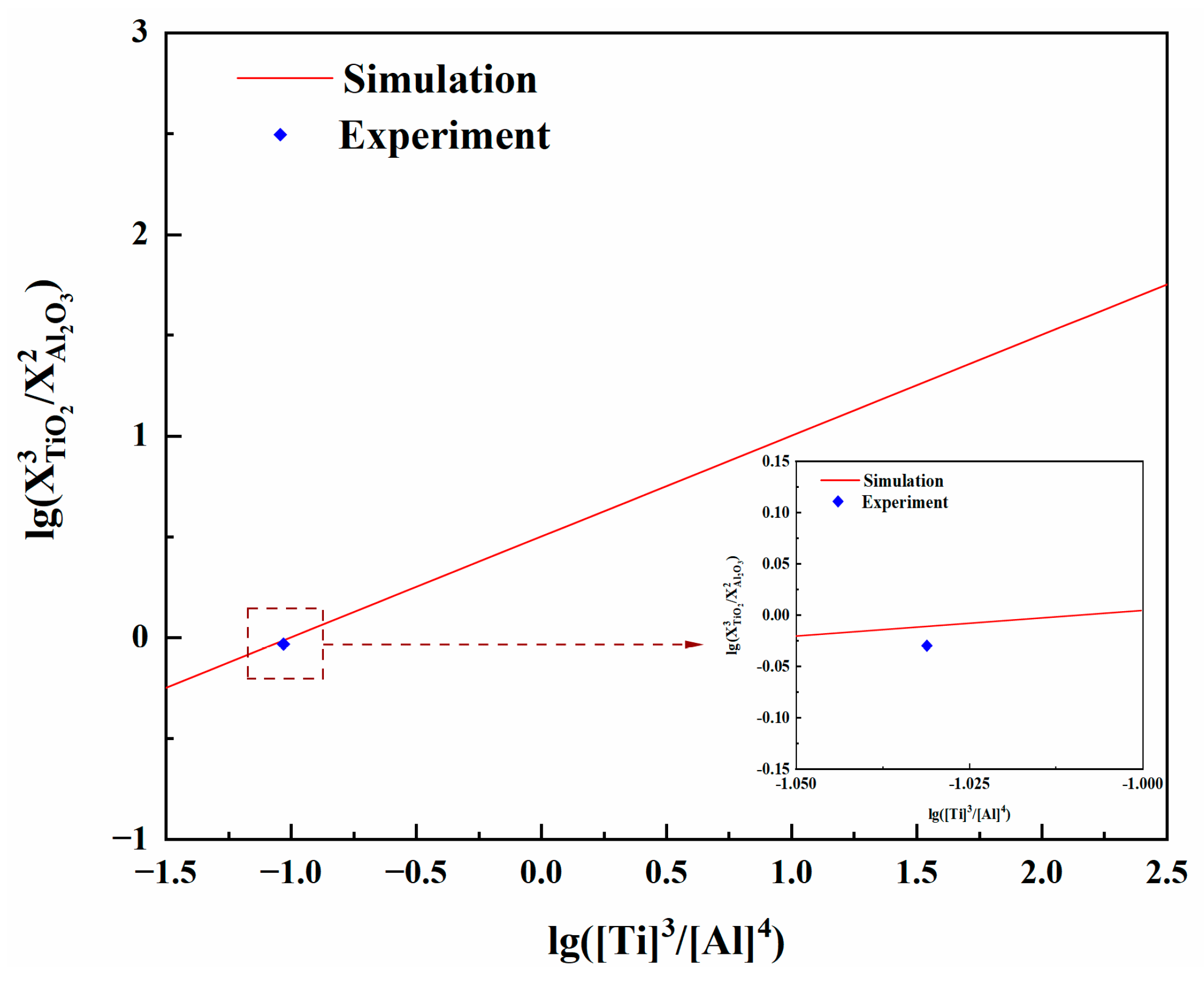
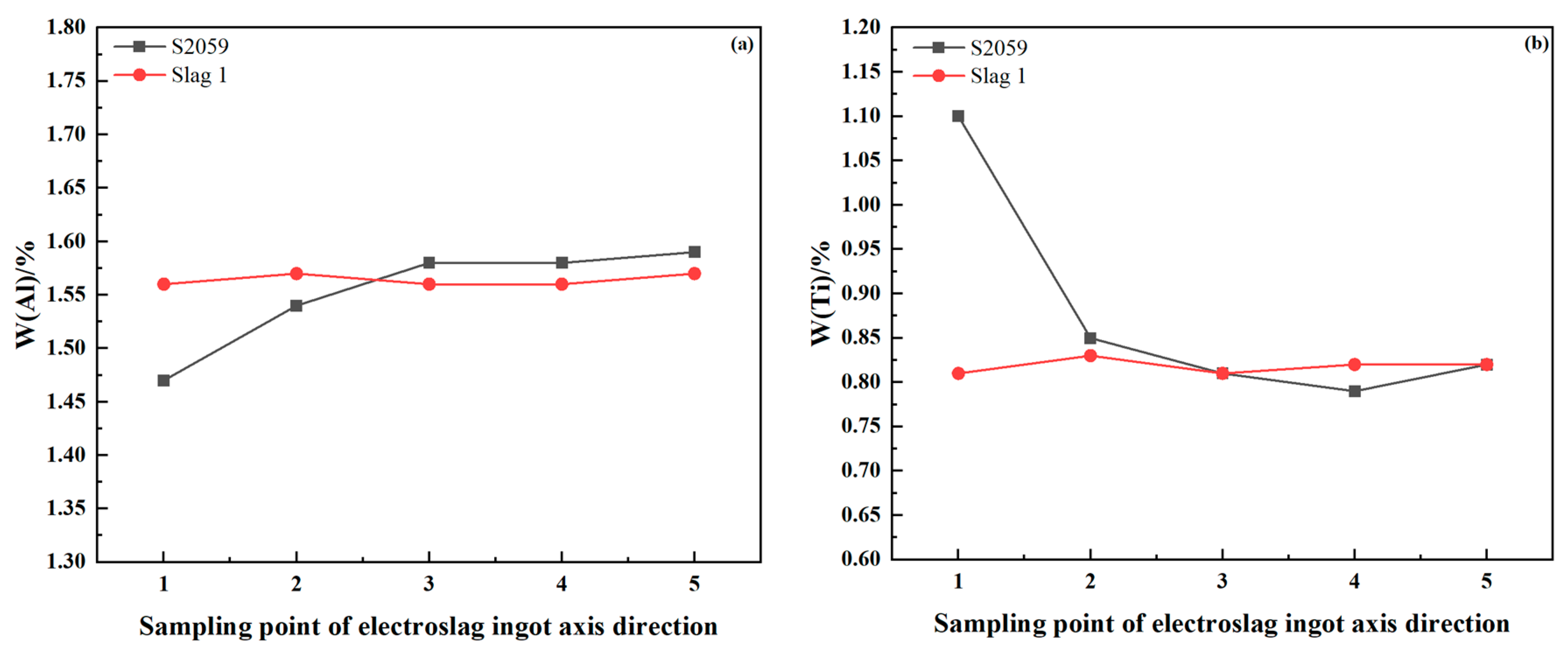
| Nb | Cr | Ni | Al | Ti | Mo |
|---|---|---|---|---|---|
| 5.50 | 18.00 | 51.93 | 1.59 | 0.81 | 2.69 |
| Slag | CaF2 | CaO | Al2O3 | MgO | TiO2 |
|---|---|---|---|---|---|
| S2059 | 50 | 20 | 22 | 5 | 3 |
| Mn | Cr | Ni | Al | Ti | Mo | |
|---|---|---|---|---|---|---|
| Al | 0.034 | 0.045 | −0.0376 | 0.0800 | — | — |
| Ti | −0.12 | 0.025 | −0.0166 | — | 0.0561 | 0.016 |
| Items | Structural Unit | Serial Number | Moles of Structural Units n/mol | Mass Action Concentration of Structural Units Ni |
|---|---|---|---|---|
| Ions | 1 | |||
| Molecules, composite molecules | ||||
Disclaimer/Publisher’s Note: The statements, opinions and data contained in all publications are solely those of the individual author(s) and contributor(s) and not of MDPI and/or the editor(s). MDPI and/or the editor(s) disclaim responsibility for any injury to people or property resulting from any ideas, methods, instructions or products referred to in the content. |
© 2024 by the authors. Licensee MDPI, Basel, Switzerland. This article is an open access article distributed under the terms and conditions of the Creative Commons Attribution (CC BY) license (https://creativecommons.org/licenses/by/4.0/).
Share and Cite
Li, L.; Wang, M.; Zhu, Q.; Xu, X.; Yu, S.; Zhang, J.; Zhou, Y. Control of Aluminum and Titanium Contents in the Electroslag Remelting of ATI 718PlusTM Alloy. Materials 2024, 17, 1254. https://doi.org/10.3390/ma17061254
Li L, Wang M, Zhu Q, Xu X, Yu S, Zhang J, Zhou Y. Control of Aluminum and Titanium Contents in the Electroslag Remelting of ATI 718PlusTM Alloy. Materials. 2024; 17(6):1254. https://doi.org/10.3390/ma17061254
Chicago/Turabian StyleLi, Lesong, Minqing Wang, Qintian Zhu, Xiaopeng Xu, Sifan Yu, Jian Zhang, and Yang Zhou. 2024. "Control of Aluminum and Titanium Contents in the Electroslag Remelting of ATI 718PlusTM Alloy" Materials 17, no. 6: 1254. https://doi.org/10.3390/ma17061254




